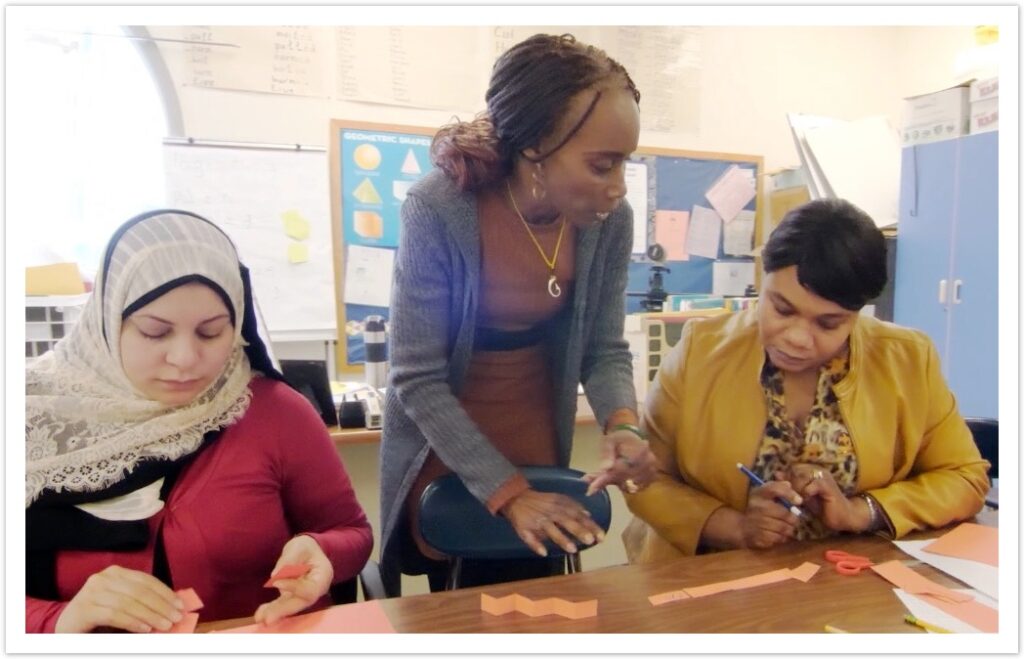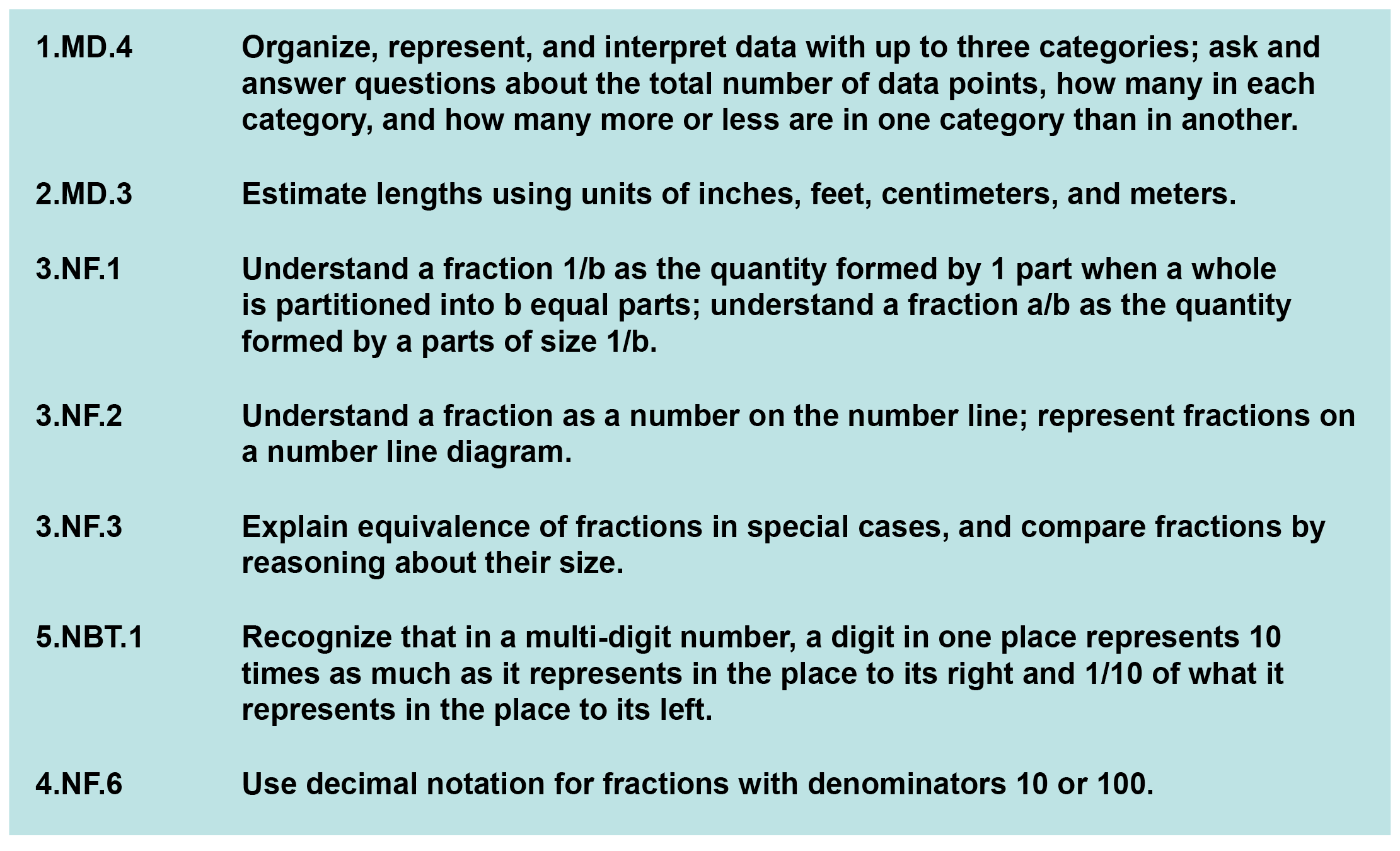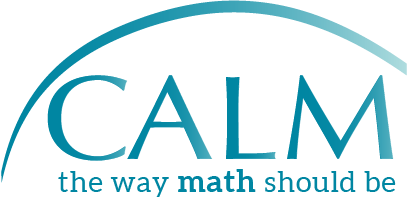Here are some of the most common questions that we receive about CALM.
If you have a question that’s not addressed on this page, please contact the SABES Mathematics and Adult Numeracy Curriculum & Instruction PD Center at adultnumeracy@terc.edu.

CALM: The Big Picture
One of the key shifts in mathematics teaching described in the CCRSAE is rigor, which says that math instruction should incorporate conceptual understanding, procedural skill and fluency, and application with equal intensity. Traditional math instruction generally focuses on memorizing procedures. The main focus of CALM is conceptual understanding, and application is addressed through performance-based assessments. Procedural skill and fluency is built through work on conceptual understanding and application. CALM focuses on connections throughout, so what students learn in Unit 1 is reinforced and built on in later units. CALM does not teach a unit on fractions, then a unit on geometry, etc. as is done in traditional workbooks. Instead CALM integrates the domains so that students see connections and understand how math is an integrated set of coherent ‘big ideas’, much like we all experience in our everyday life and work. All of this is achieved with CALM’s complete curriculum, which includes full lesson plans, hands-on activities, and assessments.
YES! Click here for a summary of those requirements (all of which are incorporated into CALM). CALM, as a complete curriculum, covers selected topics in levels A-D/E of the CCRSAE. The selection of topics was guided by what students need to be college-ready. Take a look at the Scope and Sequence to see what math content is covered and how it develops across the units. CALM incorporates digital literacy as appropriate to the content as is required by ALCS, providing students opportunities to explore, discover, and practice math content while also building their digital literacy.
CALM was designed to bring students from the adult basic education (ABE) level through college readiness and that means passing an HSE test with a college-ready score and placing into a credit-bearing class on the ACCUPLACER. In addition to a variety of hands-on, real-world lessons and activities, CALM includes a set of questions at the end of every unit that are written in the style of standardized tests. Even if you don’t complete all of CALM with your students, the conceptual foundation they build with CALM will improve their scores on the tests as well as preparing them for math beyond the test.
CALM lesson plans use a variety of materials and tools, some of which may already exist in your classroom. CALM includes handouts, answer keys, formative assessments, and unit assessments throughout the units; however, you will need to have some outside resources. Specifically, CALM draws upon the EMPower series heavily and also references many free online resources. Check out some sample CALM lesson plans to see how these types of resources are incorporated into the instructional design.
Timing and Flexibility with CALM
No. We have provided a comprehensive developmental model, but we know you may not be able to do it all with the limited class time you have. You know your students, so you will have to make decisions about what to cover and at what pace. If you’re not sure how to teach an activity, then use what you’re more comfortable with, but continue to be willing to learn new ways to teach topics to your students.
One good option is to take advantage of the many assessments that are already built into CALM to get an idea of which activities are appropriate for your students. Each unit has a performance task and a set of test-like questions at the end, and each lesson has a formative assessment that is linked to the objectives for the lesson. If you are not sure whether your students need the content of a particular lesson or unit, you can use these assessments to figure it out.
The entire curriculum is 22 units. It is not expected that you will be able to get to everything in one year just as you would not expect to move an adult basic education (ABE) student to college-ready in one year. After all, CALM is designed for levels 100 – 300, or ABE to adult secondary education (ASE). If you are teaching ABE students, you should not be expected to complete any of the higher levels; just start with Unit 1 and move along according to your students’ needs. If you are an ASE teacher, we recommend that you follow one of the three suggested developmental progressions at a time. The progressions focus on linear functions, data and statistics, and geometry. Because CALM integrates topics, students will still be exposed to content from other domains while doing the progressions. You also can chart your own course through the curriculum! Every teacher’s situation is different, so you should feel free to adapt the curriculum in a way that works for your students.
Units comprise anywhere from three to seven lessons. If you choose to do every lesson in the unit completely, it may take you quite a while to cover some of the longer units. This is not a cause for panic. Spending a long time on a single unit does not mean you are devoting an inordinate amount of time to a single topic because, while each unit has a focus, it also draws from and integrates skills from multiple domains. Unit 1, for example, has seven lessons and introduces students to ideas connected to number sense, proportional reasoning, algebra, and geometry. Even if it takes a long time to get through, covering unit one thoroughly will give students a solid foundation for future work, so we encourage you to take as much time as students need with Unit 1.
Each lesson is estimated to take three hours of class time. However, the amount of time it takes your class will vary depending on such factors as what material you choose to include, the level of your students, and the length and frequency of your class. Classes that meet for short amounts of time or with long gaps between meetings may take longer to do lessons.
As mentioned before, when teaching CALM, teachers may spend longer on a unit or a topic than they did in the past. This is because building conceptual understanding takes time, and CALM is also an integrated curriculum, so that every unit connects to different topics and domains rather than teaching skills in isolation. However, teachers will need to make curricular decisions to adapt CALM to their class’ needs, including when to move on to a new unit even if the current one has not been covered completely. Some things to keep in mind when judging whether a class is ready to move on:
- Are the students using the new conceptual tools from the unit (such as area models, fraction strips, or number lines) independently?
- Have students with good attendance achieved most of the unit goals?
- Is the teacher weary of the topic?
- Is there a semester break or vacation coming up that would provide a natural time to start a new topic?
Answering yes to these questions means it may make sense to move on, even if the teacher has not completed every lesson in the unit. The CALM curriculum is built to cycle back to previous concepts, so there will be future opportunities for students to review and deepen their skills. Also, it is better to make a conscious decision to move on, rather than trying to rush through concepts or short-cutting by simply teaching procedures.
Fractions, decimals, and percents and their operations span six years of the typical K-12 curriculum, and adult students at all levels often demonstrate profound gaps in these areas. In order to teach them in their full conceptual depth and with robust, real world applications, it took 8 well rounded integrated units!
However, teachers may decide that their class needs to focus on other areas before they are able to tackle the full fraction / decimal / percent sequence. For this reason, a team of CALM teachers came up with developmental progressions, which are coherent paths through the curriculum that move more quickly to a different area of focus. At the moment, there are progressions for Geometry, Data, and Linear Functions.
Classroom Variables
Open enrollment is a challenge with any curriculum. However, because CALM integrates math topics and spirals back to important concepts in different contexts, students entering your class in the middle of a lesson or unit will still have a chance to build conceptual understanding. Hands-on explorations allow students to engage with material at a variety of levels, so new students and ones who have been with you from the beginning can all explore the same material together. One useful strategy in bringing new students into a class is to ask current students to tell them a little about what you’ve been doing. This not only helps get new students on track, but it serves as a formative assessment for your current students, giving you a better sense of how they are understanding the material.
CALM assumes that every class is multilevel. Each student builds her own understanding through explorations. For almost every lesson, there is a section for further practice for those who need it. In addition, most CALM activities naturally lend themselves to differentiation as students can access the material at different levels while still participating in whole group or small group activities. Look in the lesson plans for specific suggestions on places you can provide extra scaffolding or extra challenge within an activity.
Absolutely! You can start using CALM at any time. If you are picking it up in the middle of the year and have already started with a different curriculum, you may want to look at the scope and sequence and unit overviews to figure out what you may have already covered.
There are occasionally students in adult education whose numeracy skills are below GLE 2. These students will need work with basic numeracy concepts such as counting and cardinality, the base ten system with numbers up to 100, and single digit addition and subtraction. CALM does not address skills at this level, and it may not be possible to differentiate a multi-level class sufficiently to meet the needs of these basic numeracy students. If you find yourself working with students at this level, we encourage you to reach out to the SABES Mathematics and Adult Numeracy C&I PD Team for more guidance.
If your students are in the GLE 2-4 range, our Beginning Curriculum for Adults Learning Math (BeCALM) materials may be more appropriate than CALM. The BeCALM units are available for free download at https://www.terc.edu/becalm/.
CALM is considered a “complete” HSE curriculum in that it teaches conceptual understanding of skills from roughly CCRSAE level B – E (GLE 3-12). However, the sequence and pacing works best for students whose skills are in the intermediate range, approximately CCRSAE level C (GLE 5-8). Many teachers will have classes of lower level students, or students at lower levels within a mixed level class. In this case, the content of CALM is still appropriate, but the sequence and pacing may need adjustment. Generally, teachers can accomplish this by choosing to focus on a smaller set of core objectives within each unit, and spending more time on those lessons and activities accordingly.
Here is an example of how Unit 3, Exploring Benchmark Fractions and Percents with Surveys, was adapted for a beginner level class (GLE 2-4).
The teacher started by looking at the overview document for Unit 3. The focus standards from the CCRSAE for Unit 3 are the following:

The first number in a CCRSAE code is the grade level at which it appears in the Common Core State Standards for K-12. To narrow the focus of the unit for this class, the teacher decided to focus only on the standards above in bold. In addition, in order to provide adequate time for students to master conceptual understanding with the basic benchmarks, the teacher decided to limit the class to working with ½, ¼, and ¾.
Looking then to the flowchart that summarized the focus of each lesson, the teacher decided to use Lessons 1 and 2, and the first two activities in Lesson 3. The Fraction Stations activity in Lesson 3 would be used as a final application assessment for the unit.
Getting Organized and Getting Support
It can feel overwhelming, especially when you are first getting started and are used to using more traditional workbooks. But, it often feels overwhelming when you are trying anything new, so be patient with yourself. Here are some tips to help you keep organized:
- When using the EMPower books, read through the activity in the teacher book, including sections like “Heads Up” and “Lesson in Action” which provide ideas about what to expect with the activities and how they’ve worked in other teachers’ classes. Be sure to have access to both the Teacher Book and the Student Book for each title that you are going to use.
- Look at the CALM materials list for the unit you are working on (also available in Spanish). Many materials, like square inch tiles or rulers, are used in many lessons. Find a place in your classroom to keep these things handy. In fact, it’s a good idea to always have them available for students to use, whether an activity calls for them or not.
- You don’t have to do every activity in every lesson. If you haven’t seen the activity modeled before, it might be hard to figure out exactly how to do it. In those instances, you might reach out to the SABES Mathematics and Adult Numeracy Curriculum & Instruction PD Center to connect with a math coach, or you might rely on your own way of addressing that content for now. But, as you get more comfortable, continue to incorporate more new activities!
- If you aren’t sure how an activity is supposed to go or are nervous about trying it in your classroom, reach out to the SABES Mathematics and Adult Numeracy Curriculum & Instruction PD Center. We’re here for you!
There are often ways around not having access to manipulatives. For example, long paper strips or commercially available paper yardsticks may be used in place of rulers, string, and scissors. Drawing numbers out of an envelope may be used in place of dice. Square inch tiles can be printed and cut out of paper or cardstock ahead of time. Folding and tearing paper instead of using scissors in class, or even cutting things apart in advance of class, are other options. Reach out to the SABES Mathematics and Adult Numeracy Curriculum & Instruction PD Center for ideas if you are stuck!
Those who are new to CALM should begin with either the self-paced online CALM Introduction course or attend a full-day CALM Orientation. Teachers who already have a background in using CALM should consider attending one of our facilitated CALM Support Session online workshops, where we feature a rotation of content topics.
Alternatively, individual or group coaching is also available by request.
Start with the SABES Mathematics and Adult Numeracy Curriculum & Instruction PD Center. You can also contact us at adultnumeracy@terc.edu.
